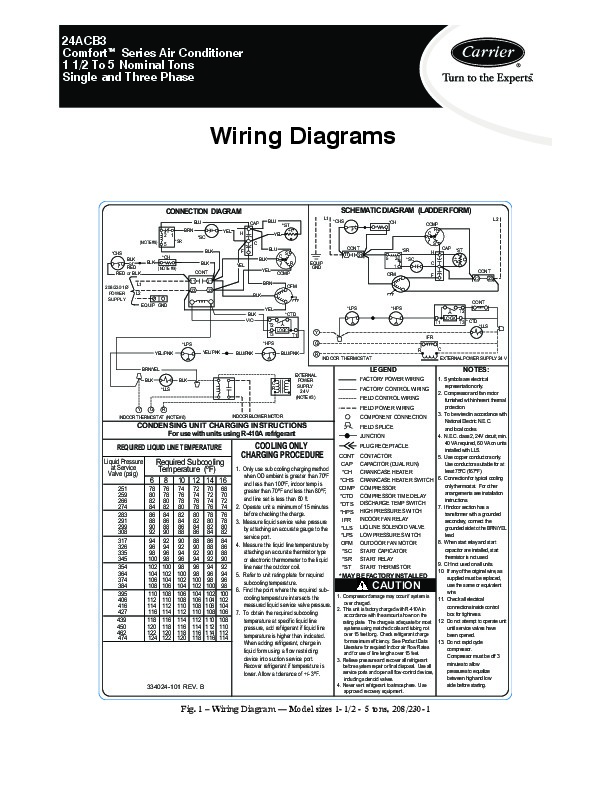Carrier Manuals Pdf
Air conditioner maintenance: • Change your air filters regularly. • Be sure to avoid blocking floor, wall or ceiling vents. • Make sure your outside condensing unit isn’t covered or clogged with leaves or debris. • Check to make sure the drainage system isn’t clogged.

Model 38TDB060300 CARRIER SPLIT SYSTEM - Manuals and Guides. View the owners manual for your CARRIER SPLIT SYSTEM Model #38TDB060300. Download Manual PDF. Carrier BDP Pdf User Manuals. View online or download Carrier BDP Owner's Manual. (Carrier Comfort Network®) Tables, which are located in Ap- pendix C of this manual. Display Module Usage. TOUCH PILOT DISPLAY — The Touch Pilot display is the standard user interface for the AquaForce 30XA chillers with the ComfortLink control system. The display includes a large. LCD (liquid crystal display) touch.
• Don’t run your system in cooling mode when outdoor temperatures are lower than 55° F or 13° C. • Have a Carrier ® expert clean your indoor coil regularly.
1232 Manual Carrier Dutch.pdf. 1232 Manual Carrier English.pdf. 1232 Manual Carrier Frans.pdf. 1232 Manual Carrier Italiaans.pdf. 1232 Manual Carrier Portugees.pdf. 1232 Manual Carrier Spaans.pdf. 1232 Manual Carrier Zweeds.pdf. 1248 Parts manual Carrier.pdf. Mounting instructions vd to carrier.
• Check for water at the base of your outdoor unit. Bob Kauflin Worship Matters Pdf Editor on this page. Water likely means the support base has shifted since installation and is no longer level.
• Consider sealing or insulating your ducts. Furnace and boiler maintenance: • Confirm that the furnace/boiler turns on and off via your thermostat by setting the temperature higher than the current indoor temperature and setting the system to heat mode. • Check the temperature of air supply grates or radiant system to ensure you’re able to feel warmth. • If you have an older thermostat that could have mercury switches, clean and level it to ensure it works properly. • Check all visible wiring and electrical connections for signs of damage like burns, unraveling wires and loose nuts. • Check vent connection pipe and chimney for rust or gaps.
(Venting systems can deteriorate over time.) • If you have a gas or oil furnace, make sure you have a clean air filter in the proper size. • When you restart your system each fall, you might consider an inspection of the burners, combustion area, venting and even flame appearance. Ventilator maintenance: First, make sure you know the type of unit you have – the serial number will have the letters ERV (Energy Recovery Ventilator) or HRV (Heat Recovery Ventilator). ERV Vacuum every three months to remove dust that would inhibit energy transfer. Don’t use water. The core should only be serviced when it’s dry and outdoor temperatures are between 60° F/16° C and 75° F/24° C. HRV Wash once a year and handle with care.
Soak the core in warm water and mild soap for three hours and then rinse under warm (not hot) water. Filters in your ventilator are washable and should be cleaned every three months. Use a vacuum cleaner to remove accumulated dust and then hand-wash in warm water. Regularly check the screen on the exterior intake hood and clean as necessary. If your system isn’t running: Check to make sure your control or thermostat is set in cooling mode. Make sure the temperature is set cooler than the current indoor temperature.
If it isn’t, your system won’t know to provide cooling. Make sure your outdoor condensing unit is running. If it is not running, make sure the breakers in your home’s breaker box or electrical panel are in the ON position. Check the main power switch for your outdoor unit, usually found within a few feet of the unit in a box mounted to the exterior of the house.
Make sure it’s in the ON position. Ensure that the blower motor in your furnace or fan coil is running. If the system is set for cooling, the blower motor should be running. If not, check to make sure your indoor unit switch is in the ON position. If your system isn’t cooling enough: Check the filter for buildup. If you have one-inch-thick furnace filters, a once-a-month change is recommended. Two-inch-thick filters – and other high-capacity pleated filters – usually only need to be changed every other month, depending on the type.